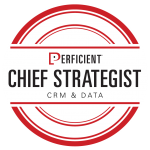Thrilling our clients with innovation and impact – it’s not just rhetoric. This belief is instrumental for our clients’ success. In 2018, we introduced our Chief Strategists, who provide vision and leadership to help our clients remain competitive. Get to know each of our strategists as they share unique insights on their areas of expertise.
Understanding consumers’ expectations, behaviors, and motivations are essential to providing better customer experiences. To attain this objective, business leaders must reconsider their view of data and customer relationship management (CRM) systems. In fact, global spending on CRM grew by 15.6 percent in 2018, accounting for more than $48.2 billion in worldwide investment.
 As investment in CRM increases, a variety of solutions have also emerged to help businesses achieve responsiveness and accuracy with customer analytics programs. The evolving market for CRM systems may be daunting for business leaders. However, the wide array provides an opportunity for customizing solutions to satisfy a specific need.
As investment in CRM increases, a variety of solutions have also emerged to help businesses achieve responsiveness and accuracy with customer analytics programs. The evolving market for CRM systems may be daunting for business leaders. However, the wide array provides an opportunity for customizing solutions to satisfy a specific need.
Mike Porter, CRM and Data Chief Strategist, has more than 21 years of experience helping clients define data strategies and build CRM solutions that meet their present and future needs. We recently spoke with Mike and learned more about his aspirations as a Chief Strategist and his perspectives on data and CRM solutions.
What does this new role as a Chief Strategist mean to you?
 Mike Porter: Clients often come to us with a very specific problem. Our Chief Strategists differentiate themselves by offering advice that ultimately helps them achieve a desired outcome rather than solving a limited ask. Beyond that, Chief Strategists deploy industry-specific knowledge to elevate the conversation. We’re not only addressing a specific, current issue; we also challenge clients to broaden their perspectives and think about the problem at a more universal level.
Mike Porter: Clients often come to us with a very specific problem. Our Chief Strategists differentiate themselves by offering advice that ultimately helps them achieve a desired outcome rather than solving a limited ask. Beyond that, Chief Strategists deploy industry-specific knowledge to elevate the conversation. We’re not only addressing a specific, current issue; we also challenge clients to broaden their perspectives and think about the problem at a more universal level.
I’m passionate about sitting at the table with our clients, taking stock of their [data and CRM] needs, and seeing how they compare and differ across the organization. I enjoy partnering with them and creating a roadmap that aligns with what they want to achieve. Then, we know we’re moving forward with the correct steps.
Sometimes the correct steps may not necessarily involve more technology. The best option might focus on the alignment of people, organizational change management, or modifying existing tactics to create a better user experience.
How would you describe your domain of expertise?
MP: Simply put, customer relationship management helps enterprises manage their interactions with current and potential customers. However, CRM takes on different meanings, depending on who you ask and the individual’s role within an organization.
Many people commonly view CRM as a platform to drive sales and enable customer service. The new reality is that CRM systems are relevant across all parts of a business. Considering the data captured by CRM systems, many organizations don’t fully recognize the variety of benefits.
Because of this new reality, we’ve identified that our clients need help determining what CRM means to their organizations. Then, we assist with developing CRM solutions that achieve their specific needs. These solutions can take many forms, such as a traditional CRM product that uses data analysis to gain insight into customer behavior. Or, it could be a combination of CRM, marketing products, and knowledge management products that you then have to integrate.
Working with our data and emerging solutions teams, we further optimize these solutions to ensure they provide the right insight, at the right time, and with the right context to drive decision making and inform other strategic functions.
“The new reality is that CRM systems are relevant across all parts of a business.”
What do you hope to accomplish as a Chief Strategist?
MP: Overall, I hope to change business leaders’ perspectives about data and CRM. I want to help clients gain a better understanding of how data can help them and demonstrate how data can influence their business decisions.
Additionally, I want to bridge the gap that exists between data-oriented people, who live in realms of mass amounts of data, and the broader business teams. The business typically doesn’t want to dive into that level of detail, but various teams still need specific insights.
Concerning CRM, I look forward to helping clients shift their limited view to a holistic perspective that influences broader strategies. By doing so, our clients can create information systems that enable relevant and valuable experiences across the customer lifecycle at multiple touch points.
Strategically Speaking
Why do businesses need a data strategy?
MP: Once businesses reach a certain size, they typically create large volumes of different data. This data commonly lives in various locations. Additionally, multiple people access the data for creating insights and monetizing its value.
Over time, this process replicates as people create multiple versions of the truth, which distorts and skews a full picture of the data. When this happens, businesses can’t take full advantage of their information and inevitably limit their economies of scale.
The [purpose of] a data strategy is to help businesses take a step back, redefine their approach for collecting data, and assign value across an entire business with a trusted set of data. Creating reports exemplifies how many organizations begin and end their data strategy. When you solely rely on this age-old approach, your business limits the potential of its data.
We come alongside our clients to help them view data as the carrot rather than the stick. Then, we supply organizations with tools to use data in ways that provide insight in context and leads to actionable results.
When you pair CRM systems with data, how does this help clients with digital transformation?
MP: Many businesses, including clients we’ve helped, view digital transformation as one specific approach. In reality, digital transformation drives change across the entire organization.
Businesses seeking to create new, or improve existing, customer experiences must have CRM and data as core components of their strategy. Data should inform businesses of customers’ behavior with CRM as the glue that holds it together and drives personalized experiences.
Think Like a Chief Strategist
How do you help clients develop a strategy for digital transformation?
MP: Every strategy needs a vision to align with the execution. To achieve that, key stakeholders must have a seat at the table. Their involvement helps me understand:
- Their current use of CRM and customer data;
- The insights they want from a CRM;
- Their vision for how those insights will influence business strategy; and
- How they ideally orient that information.
Tell us about a recent project you’ve tackled. How did we help the client achieve success?
MP: We recently helped a major healthcare provider ensure that its digital channels, including web, mobile and social, reach current and future patients. From a competitive standpoint, the client needed a strategy to bring it up to speed. We assimilated [the right stakeholders] early to determine their vision and investment. This step established a foundation of understanding so we could help the business reinvent its digital customer experience.
The final solution required significant mobile, backend, and website optimization. We identified the end goal, created roadmaps for each aspect of the project, and outlined the steps involved to get them there.
As a result, we improved the client’s ability to collaborate with internal customers and better serve its patients. The provider now has a solid foundation on which to make future improvements by optimizing its digital presence.
This was an extremely successful engagement. In fact, we’re now entering the second phase of our relationship and creating the next generation roadmap for future growth opportunities.
Looking ahead to 2020, what should business leaders think about in terms of digital transformation?
MP: In the technology industry, we like to focus on the next big thing. However, business leaders should recognize that no single [technology] trend will make or break their success in the coming year.
There will always be new technology that could have a place within a business strategy. Instead of following trends, business leaders must be proactive in establishing a foundation that will create agility within their organizations. This agility will allow their business to move quickly as new digital transformation investments are identified.
“Maintaining a position that prepares an organization for quickly adapting to change should be the goal of any organization.”
Beyond the World of Strategy
What are your interests or hobbies when you’re not wearing the Chief Strategist hat?
MP: First and foremost, I have a saint of a wife. With six kids, we spend the majority of our time raising good, well-rounded kids and giving them cool experiences. We recently took a trip to the Boundary Waters in northern Minnesota. It’s a vacation I’ve wanted to take with my family for 20 years. This beautiful, remote area of Minnesota doesn’t allow any kind of motors. Most of the traveling is by canoe. There’s also no cell signal. The electronics were fairly obsolete and allowed us to spend time together without distractions.
As far as outside interests, I’m obsessed with energy efficiency. My family and I are in the process of moving into our new home, and I have really enjoyed working with contractors to make it more efficient. Some relatively simple steps can make a big impact, such as replacing installation in our attic and crawlspace to help with airflow. We’ve also sealed off the gaps behind electrical outlets and light switches to cut off air flow from the outside. Perhaps I wouldn’t call it a hobby, but I’m definitely an enthusiast.

